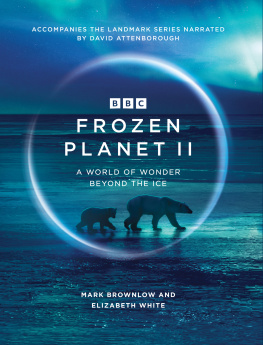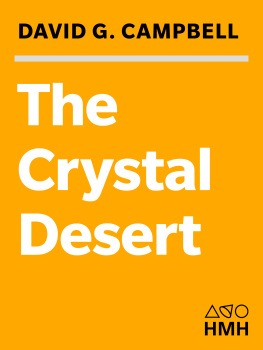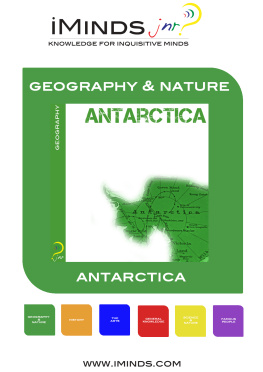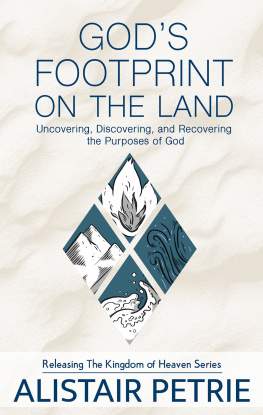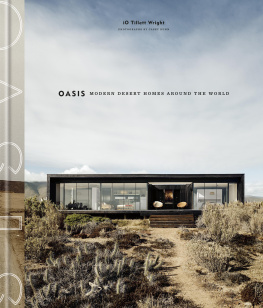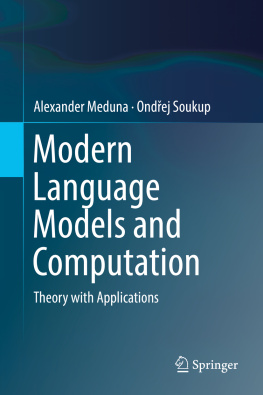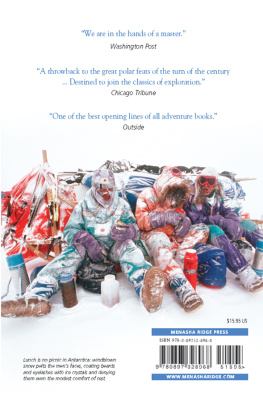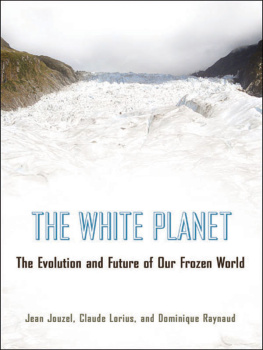Meduna - Science on ice: discovering the secrets of Antarctica
Here you can read online Meduna - Science on ice: discovering the secrets of Antarctica full text of the book (entire story) in english for free. Download pdf and epub, get meaning, cover and reviews about this ebook. City: Antarctica, year: 2013;2012, publisher: Auckland University Press, genre: Romance novel. Description of the work, (preface) as well as reviews are available. Best literature library LitArk.com created for fans of good reading and offers a wide selection of genres:
Romance novel
Science fiction
Adventure
Detective
Science
History
Home and family
Prose
Art
Politics
Computer
Non-fiction
Religion
Business
Children
Humor
Choose a favorite category and find really read worthwhile books. Enjoy immersion in the world of imagination, feel the emotions of the characters or learn something new for yourself, make an fascinating discovery.

- Book:Science on ice: discovering the secrets of Antarctica
- Author:
- Publisher:Auckland University Press
- Genre:
- Year:2013;2012
- City:Antarctica
- Rating:3 / 5
- Favourites:Add to favourites
- Your mark:
- 60
- 1
- 2
- 3
- 4
- 5
Science on ice: discovering the secrets of Antarctica: summary, description and annotation
We offer to read an annotation, description, summary or preface (depends on what the author of the book "Science on ice: discovering the secrets of Antarctica" wrote himself). If you haven't found the necessary information about the book — write in the comments, we will try to find it.
Meduna: author's other books
Who wrote Science on ice: discovering the secrets of Antarctica? Find out the surname, the name of the author of the book and a list of all author's works by series.
Science on ice: discovering the secrets of Antarctica — read online for free the complete book (whole text) full work
Below is the text of the book, divided by pages. System saving the place of the last page read, allows you to conveniently read the book "Science on ice: discovering the secrets of Antarctica" online for free, without having to search again every time where you left off. Put a bookmark, and you can go to the page where you finished reading at any time.
Font size:
Interval:
Bookmark:
DISCOVERING THE SECRETS OF ANTARCTICA
VERONIKA MEDUNA

for Andy and Lukas,
who are yet to see the ice
Introduction
A Land of Ice
Uncovering the Past
Life on Ice
True Antarcticans
Oasis in a Frozen Desert
Coda
Beyond the Ice

During an Antarctic summer, the sun circles above the horizon but never sets. PETER MARRIOTT
I will never forget my first breath of Antarctic air. It was by no means pristine. I had arrived by air and was following a long line of padded black and red parkas through the exit hatch of our C-130 Hercules. Outside, several vehicles, including the American McMurdo Stations huge terra-bus Ivan, were waiting with their engines running. Nevertheless, this first breath felt like nothing else. It wasnt the coldest air I had ever inhaled, but it was certainly the driest. I could almost feel my throat turn to parchment.
Looking back at the plane, the image of an enormous brooding hen, which Id come across in Pamela Youngs travelogue Penguin Summer, suddenly made perfect sense. Young had endured several summers during the 1960s as an ice widow while her husband Euan was studying skuas, until she insisted on joining him. During the summer of 1969/70, she became the first woman to work at New Zealands Scott Base. Ironically, she had travelled on a Starlifter, a more modern version of aircraft than the cargo plane that had ferried me to the ice.
Unfortunately, I didnt get a ride on Ivan. A small 4WD truck was waiting for the New Zealanders. Getting from the runway on the sea ice to my four-bunk room at Scott Base remains a blur. I tried to take in the views, searching for landmarks I might recognise from photographs and maps, and I tried to chat with my fellow passengers, some of whom I had met before under more ordinary circumstances. I failed at both. In fact, I continued to feel utterly bewildered, overwhelmed and confused for much of my first few days on ice.
Strange as it may seem, I was almost grateful for the small electric shocks newcomers to Scott Base receive regularly. Antarctic air is so dry that even walking a short distance along the carpeted floors builds up static, and as soon as you touch one of the metal pillars of the buildings frame zap, another reminder that this place really is like no other. The trick is to discharge the static often, before it can build up to cause painful shocks, and once I had learned that and joined everybody else at base in a zigzag shuffle from post to post, I started to feel a little more at home.

Ivan, the terra-bus, waits to ferry American scientists and staff from the ice runway to McMurdo Station.

Originally, Scott Base was a bright orange, red and yellow, but in 1965 it was repainted in green. Several stories exist about how the colour was chosen. Some say the green was selected in keeping with the image of New Zealands landscape, but others claim that the then superintendent, Bob Thomson, remembered a trip to Ireland where he liked the white cottages surrounded by green and he reversed this scheme for Scott Base. The paint used today is Chelsea cucumber. ANTARCTICA NZ PICTORIAL COLLECTION: MARK MITCHELL/K310 03/04

Antarctic Field Training is a compulsory exercise in survival. Participants first learn how to walk on crampons, cross crevasses safely and arrest a fall with an ice axe. Then everyone has to build a shelter and spend a night in it but with spectacular views of Mount Erebus few actually sleep for long. The yellow polar tents in this photograph are Antarctic-style portaloos.
After a short and fitful sleep at Scott Base, with the windows shuttered to keep out the midnight sun, I found myself hurtling down a snow slope, head first, and cutting blocks of compacted snow to build an emergency shelter. Antarctic Field Training, or Happy Campers for those based at McMurdo Station, is an ultra-short compulsory introduction to basic snowcraft and mountaineering techniques and a rare chance to spend a night in a snow cave or igloo with a view of Mount Erebus.
I will also never forget my first experience of Antarctic silence. I had left Scott Base for a field camp on the Victoria Lower Glacier. During the day, the hum of a small generator and the whir of an ice-core drill combined with the wind to create a ceaseless soundscape. But one bright night, with all machines quiet and everybody else fast asleep, the wind stopped. There was no way I could sleep and I crawled out of my double sleeping bag and back into my extreme-weather gear. The rustling of my parka and the ripping of Velcro and zips was deafening. Once out of my tent, my steps seemed to echo across the entire glacier. Then I stood absolutely motionless for a few moments, and there was nothing. It was so still that I could hear the eerie rush of my own blood, and my breathing seemed an intrusion.
The superlatives that have been used to describe Antarctica are familiar even to those who have never set foot on the ice. It is the coldest, windiest, driest and highest continent on Earth and the largest of the worlds deserts. But looking out across the vast flatness of the glacier that night, I felt the utter remoteness and wildness of the last place to be discovered and to submit to the presence of people.
Antarctica is the only continent without permanent human habitation, yet it may hold the key to our survival. Its ice cap holds three quarters of the planets fresh water, its layers of ice and sediment record past climate conditions going back millions of years, and the oceans around it drive the global food chain and a giant conveyor belt of currents that transports heat around the globe. The creatures that call Antarctica home have evolved to survive in conditions hostile to life, and the continents permanently ice-covered lakes may even contain the secret to how life began on Earth and what it might look like elsewhere.
This icy wonderland is the worlds fifth-largest continent and represents a tenth of our planets landmass. It is a place of contradictions: active volcanoes erupt from a frozen landscape, ice stretches as far as the eye can see yet it hardly ever snows and the arid desert is surrounded by the ocean. Antarcticas shape has been described as a giant stingray, lying flat across the end of the world with its tail sticking out towards the southern tip of South America. This extension, the Antarctic Peninsula, is unlike the rest of Antarctica in almost every aspect. Its climate is less extreme and as a consequence it harbours more life. Scientists have grouped it with several smaller islands into the separate category of maritime Antarctica. The rest of the frozen land, continental Antarctica, is truly a land of ice. There are so many different types of Antarctic ice that the continent comes with its own vocabulary.
Antarctica has two ice sheets, massive frozen blankets that cover vast stretches of land and bury entire mountain ranges. The larger East Antarctic Ice Sheet is 4 kilometres high at its maximum and hundreds of kilometres from one end to the other. It holds most of Antarcticas ice. If it were to melt, the worlds oceans would rise by at least 60 metres. Its smaller sibling, the West Antarctic Ice Sheet, sits deep below sea level and is therefore considered more dynamic. Its ice tongues are submerged in water and could break up rapidly as the ocean warms, with the capacity to raise global sea levels by 6 metres. Together the ice sheets weigh down the land beneath so much that they deform the planet under the South Pole. They connect land to sea, sea to air, and another superlative form the largest yet simplest landform on Earth: the Polar Plateau.
Font size:
Interval:
Bookmark:
Similar books «Science on ice: discovering the secrets of Antarctica»
Look at similar books to Science on ice: discovering the secrets of Antarctica. We have selected literature similar in name and meaning in the hope of providing readers with more options to find new, interesting, not yet read works.
Discussion, reviews of the book Science on ice: discovering the secrets of Antarctica and just readers' own opinions. Leave your comments, write what you think about the work, its meaning or the main characters. Specify what exactly you liked and what you didn't like, and why you think so.

